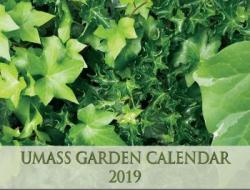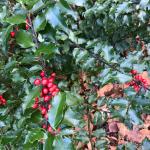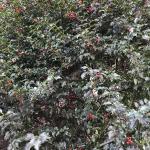A monthly e-newsletter from UMass Extension for landscapers, arborists, and other Green Industry professionals.
To read individual sections of the message, click on the section headings below to expand the content:
Hot Topics
 Thank your clients with a 2019 UMass Garden Calendar!
Thank your clients with a 2019 UMass Garden Calendar!
Cost: $14, with a bulk rate available for quantities of 10 or more.
Gardening is enjoyed by so many people — it can ease stress, keep you limber, and even improve your mood! To help keep your plants healthy, productive, and beautiful, the 2019 UMass Garden Calendar offers helpful guidelines, daily tips, and an inspiring garden image each month!
For many years, UMass Extension has worked with the citizens of Massachusetts to help them make sound choices about growing, planting and maintaining plants in their landscapes, including vegetables, backyard fruits, and ornamental plants. Our 2019 calendar continues UMass Extension’s tradition of providing gardeners with useful information. This year’s calendar features the use of tomography to identify internal decay in mature trees that do not yet show any visible symptoms of damage, making it difficult to assess their potential risk in urban and suburban settings.
Each Month Features
- An inspiring garden image
- Daily gardening tips for Northeast growing conditions
- Daily sunrise and sunset times
- Phases of the moon
- Plenty of room for notes
- Low gloss paper for easy writing
ORDER ONLINE at www.umassgardencalendar.org
Questions & Answers
Q. What landscape plants are most susceptible to winter injury?
Broad-leaved evergreens, such as rhododendron, azalea, mountain laurel, andromeda, holly, among others, often experience winter injury in this region. Additionally, non-native conifers that are marginally hardy (depending on your local plant hardiness zone), such as blue atlas cedar and Japanese cryptomeria, can be severely impacted at times. Finally, native conifers like eastern hemlock have also experienced cold weather injury in recent years. Symptoms on broad-leaved evergreens typically first appear as yellowing/browning along the midrib that expands towards the leaf margins as conditions warm in the spring. Curled leaves on rhododendron may remain curled and become desiccated as the growing season begins. Also, scattered leaf spots and blotches may be present.
Symptoms of winter burn on conifers can range from localized to widespread needle browning in the canopy. The damage tends to first develop on the needle tips and then spreads towards the base. However, it can also occur sporadically across the needle. Widespread needle browning in the canopy can result in serious canopy dieback on certain landscape trees. Conifers may become susceptible to freeze injury after drought, insect infestation or a disease outbreak disrupts their ability to properly acclimate to cold weather prior to the onset of cold weather. Freeze injury can occur after a partial deacclimation of cold hardiness takes place due to above-average temperatures in late winter or early spring. Finally, mild winter days can result in water loss via transpiration from needles and leaves of landscape evergreens, especially when reflective snow cover is present. The transpired water cannot be replaced because the roots and soils are frozen, leading to desiccation of the foliage.
Q. How concerned should I be about boxwood blight in 2019?
Very concerned! The boxwood blight epidemic of 2018 means there is a large volume of overwintering inoculum (infected plant parts capable of initiating new infections) in the landscape right now. Infected leaves and stems that fall to the ground can become incorporated into the organic layer, where the fungus can persist even after infected plants are removed. Root infections by the boxwood blight pathogen are rare, but the roots of infected plants should be removed from the site when plants die as a result of this disease.
Most boxwood blight cases are associated with recently transplanted shrubs that were harboring the disease upon purchase. Carefully monitor recently transplanted boxwoods for the development of symptoms in the months after establishment. Avoid overhead irrigation, which provides the necessary moisture on leaves and stems for disease development and helps to spread spores once they form. Symptoms of infection first appear as dark-colored leaf spots and lesions on fine stems. This is quickly followed by leaf shedding and canopy dieback, making it essential that plants are regularly scouted for any symptoms of the disease.
Nicholas J. Brazee, UMass Extension Plant Pathologist
Trouble Maker of the Month
An Often Overlooked Weed Management Opportunity
As we build weed management programs for turf and landscape settings, it is important to take advantage of every opportunity at our disposal. One such opportunity occurs during the establishment and/or renovation process that often occurs in the turf and landscape areas we manage. It is at times hard to fight the temptation to adopt the “plant now and worry about it later” strategy. This is a path that will likely result in great regret down the road. Weed management at the start of a project can solve many difficult weed problems. The expression “let’s start with a clean slate” should be in the back of your mind as you plan and implement establishment and/or renovation projects in turf and landscape areas.
Situations where the “fresh state/clean slate” approach may be warranted
Turf:
- Weeds cover exceeds 50 percent.
- The presence of difficult-to-control weeds as a result of neglect and/or ineffective management.
- Lack of effective cultural or selective herbicidal options for specific weed species.
- Perennial weeds with asexually vegetative means of reproduction (creeping roots, rhizomes or nutlets).
Landscape:
- The presence of difficult-to-control weeds (including invasive plants) as a result of neglect and/or ineffective management.
- Lack of existing effective cultural or selective herbicidal options for specific weed species.
- Perennial weeds with asexually vegetative means of reproduction (creeping roots, rhizomes or nutlets).
Implementation guidelines
A non-selective, translocated herbicide such a glyphosate is the most appropriate when implementing the “fresh state/clean slate” approach. Contact herbicides such as diquat (Reward), pelargonic acid (Scythe) and non-chemical products that contain clove oil, citric acid, acetic acid or orange extract are not suitable. These contact herbicides will not control perennial weeds, especially those with asexually vegetative means of reproduction.
Turf: In turf, the “fresh state/clean slate” strategy focuses primary around the establish of a new turf area when little, if any, of the previous turf is worth saving.
- Late summer and early fall (August 14 to September 15) is the best time for turf establishment by seed.
- In preparation for turf establishment, treat area with glyphosate, a non-selective, translocated herbicide in early to mid-July. If perennial weed regrowth is observed, another application can be made before seeding. There is no need to be concerned with summer annual weeds (crabgrass, carpetweed, spotted spurge and purslane) that may germinate this late is the season.
- Collect and submit a soil test. Soil test results will indicate if corrective measures regarding soil pH and fertility are necessary.
- Select a seed mixture appropriate for the site based on site conditions and intended turf area use. This mixture should contain turf species and cultivars of those species that are best adapted to the most limiting site factors (fertility, shade, moisture, traffic/wear and site use).
- Seeding can be done with an overseeder and there is no need to remove the dead surface layer.
- Turf establishment at the end of the growth season while not require a preemergence herbicide application. If annual bluegrass (Poa annua) is a problem, an application of mesotrione (sprayable or on-starter fertilizer formulation) will suppress this fall-germinating winter annual weed.
- Application of a starter fertilizer (water-soluble, quick release) is recommended.
- Irrigation should be applied in the absence of adequate rainfall.
- In the spring following turf establishment, standard weed management practices should resume.
Landscape: In a landscape setting, the “fresh state/clean slate” strategy focuses primarily around the installation of a new landscape, as it may be difficult to convince your customer to rip out an existing landscape with the sole purpose of managing weeds. However, if the landscape ornamentals are overgrown and weeds, including invasive plants, are present, it might be something to consider.
- Determine the most troublesome weed species at the site.
- While glyphosate may provide acceptable control for many weed species, it might not be effective enough and another herbicide will need to be used or incorporated.
- In most cases, the control of weeds should begin well in advance of the installation of landscapes ornamentals. For spring installations, weed management strategies might need to started the previous growing season. For late season installations, weed management can begin early in the season. While this may be viewed as a lengthy process, it is important to make sure that your weed management objectives are obtained before planting begins.
Randy Prostak, UMass Extension Weed Specialist
Plant of the Month
Ilex x meserveae, Blue holly or Meserve holly
Blue holly, or Meserve holly, is an evergreen hybrid holly of Ilex aquifolium x Ilex rugosa. They are shrubby in habit and have alternate, leathery, glossy dark green almost blue-green leaves with spiny margins. Plants typically grow to 8-10 feet tall, but occasionally to as much as 15 feet tall. They bloom in May with greenish-white flowers in small clusters which produce showy bright red berries on female plants in fall. The berries often persist until spring. Flowers, although not ornamental, attract bees and the fruits are attractive to birds. Like other hollies, Meserve holly plants are dioecious (separate male and female plants). One male pollinator is needed for every 3 to 5 female plants for berry production. Blue hollies are winter hardy to USDA Zones 5 - 8.
Plants are best sited in locations protected from cold winter winds. Blue holly grow best in slightly acidic, moist, well-drained soils in full sun to part shade. Part afternoon shade is best in hot summers. Blue hollies can be used in mass plantings, hedge or borders, foundations and as specimen plants. Potential problems include interveinal chlorosis (yellowing of leaves in high pH soils), holly leaf miner, spider mites, whitefly and scale, leaf scorch, tar spot, and phytophthora root rot.
Cultivars include:
- ‘Blue Princess' (female) – 15 feet tall, dark blue green foliage and an abundance of red fruit
- ‘Blue Prince' (male) – 8 - 12 feet tall, and very dense, with dark green foliage, very cold hardy.
- ‘Blue Girl' (female) – 8 - 10 feet tall, dark green foliage and bright red fruit.
- ‘Blue Boy' (male) – 10-15 feet tall; dark green leaves.
Geoffrey Njue, UMass Extension Sustainable Landscapes Specialist
Upcoming Events
Spring Kickoff: UMass Extension Landscape Education Day
March 28, 2019 - 9:00 am to 3:30 pm
Location: TownePlace Suites, Wareham MA
Sustainable landscaping uses multiple management strategies that seek to reduce negative impacts on the environment while maintaining aesthetically pleasing landscapes. Learn about effective pest management strategies and practices that provide beautiful and environmentally friendly landscapes for your customers. Topics include: updates about winter moth and gypsy moth and successes with using biological control; attracting birds in designed landscapes; effective strategies for managing landscape weeds; and taming the top 10 troublesome diseases of woody landscape plants.
4 pesticide contact hours for categories 29, 36, and Applicators License.
Registration and Additional Information.
Other Upcoming Events:
- 3/14: State Regulations Pertaining to Invasive Plant Management (part A2 of the Invasive Plant Certification series), Milford, MA
- 3/19: The Invasive Plant Issue and Invasive Plant Identification (part A3 of the Invasive Plant Certification series), Milford, MA
- 3/28: Spring Kickoff: UMass Extension Landscape Education Day, Wareham, MA
- 4/9: Developing an Invasive Plant Management Program (part B of the Invasive Plant Certification series), Milford, MA
- 4/24: Ticks and Tick-Associated Diseases Conference, Milford, MA
- 4/29: Landscape Pests and Problems Walkabout - Diseases, Weeds, Insects, and Cultural Problems, Amherst, MA
For more information and registration for any of these events, go to the UMass Extension Landscape, Nursery, and Urban Forestry Program Upcoming Events Page.
Additional Resources
For detailed reports on growing conditions and pest activity – Check out the Landscape Message
For commercial growers of greenhouse crops and flowers - Check out the New England Greenhouse Update website
For professional turf managers - Check out Turf Management Updates
For home gardeners and garden retailers - Check out home lawn and garden resources. UMass Extension also has a Twitter feed that provides timely, daily gardening tips, sunrise and sunset times to home gardeners, see https://twitter.com/UMassGardenClip
Diagnostic Services
A UMass Laboratory Diagnoses Landscape and Turf Problems - The UMass Extension Plant Diagnostic Lab is available to serve commercial landscape contractors, turf managers, arborists, nurseries and other green industry professionals. It provides woody plant and turf disease analysis, woody plant and turf insect identification, turfgrass identification, weed identification, and offers a report of pest management strategies that are research based, economically sound and environmentally appropriate for the situation. Accurate diagnosis for a turf or landscape problem can often eliminate or reduce the need for pesticide use. For sampling procedures, detailed submission instructions and a list of fees, see Plant Diagnostics Laboratory
Soil and Plant Nutrient Testing - The University of Massachusetts Soil and Plant Nutrient Testing Laboratory is located on the campus of The University of Massachusetts at Amherst. Testing services are available to all. The function of the Soil and Plant Nutrient Testing Laboratory is to provide test results and recommendations that lead to the wise and economical use of soils and soil amendments. For complete information, visit the UMass Soil and Plant Nutrient Testing Laboratory web site. Alternatively, call the lab at (413) 545-2311.

